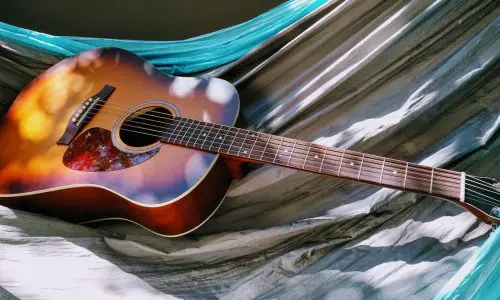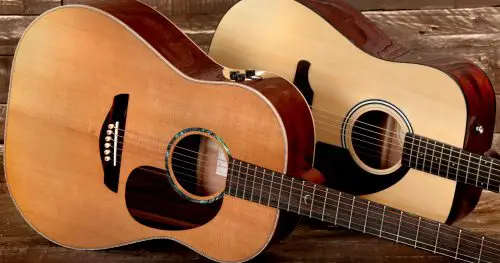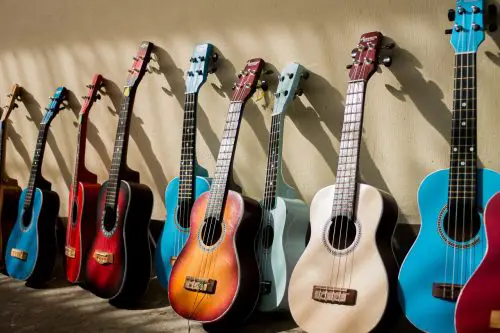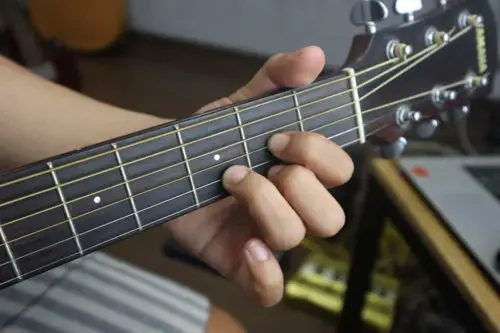Purchasing a guitar can be a scary experience. Especially since a good guitar is not cheap. There are several factors that go into a new guitar purchase that should be taken into consideration.
As someone who has played both guitar and bass for over seven years, I can confirm that a guitar purchase is a huge investment.
I know from personal experience that finding the best possible quality of guitar for your budget can be a challenge.
Additionally, just having one or two of these traits does not necessarily mean that you are getting a high-quality guitar.
The term high quality guitar can mean a great deal of different things to many different guitar players. Since this is such an objective term, we will go over seven traits that are common to high quality guitars.
Once you can spot these, you will be much less likely to end up with a higher quality guitar than a lower quality guitar.
We will also go over what else to look for when you are shopping for a new quality guitar. We will also go over three frequently asked questions by people when searching for a high-quality guitar.
Also Read: High E Vs Low E Guitar Strings: Why Are There 2 Of Them?
7 Traits Of a High-Quality Guitar (Check Before Buying)
Although it can be largely opinion as to what a high-quality guitar is, here are seven traits of what constitutes a high-quality guitar. Please keep in mind that these are just a few of the traits that will contribute to the quality of the guitar.
A higher quality guitar will have several different factors that influence its level of quality. Just because a guitar has one or two of these traits, it does not mean that the guitar is necessarily a high-quality instrument. A high-quality guitar should have at least four of these traits to it.
1. Good Quality Wood

It is one of the only hardwoods that can make quality top wood
The quality of wood used in the guitar is a major factor regarding the quality of the guitar. Here are examples of high-quality types of wood are seen in high quality guitars. These types of wood are seen in high quality guitars for the neck and the body:
- Mahogany
- Rosewood
- Maple
- Sitka Spruce
- Koa
- Cedar
Mahogany and Rosewood are considered to be two of the better types of wood. Mahogany is very easy to work with and has a strong sustain and tone.
Rosewood also has a very clear tone to it as well. Consider going to your local music store to play different guitars constructed of these different types of wood to see which you like the most.
The quality of the wood that is used will not necessarily mean that in and of itself will create a high-quality guitar.
It will also depend on how the guitar is constructed with the wood used. Please see the second trait, solid top vs laminate top for additional information:
2. Solid top vs laminate top

A solid top refers to the soundboard, that’s the part of the acoustic guitar the audience sees
A guitar body that is one piece of wood is called a solid top. A guitar body that is composed of different pieces of wood compressed together is called a laminate top.
Generally speaking, a guitar body composed of one solid piece of wood is of a higher quality than a laminate top (a guitar body composed of different pieces of wood pressed together).
A laminate top guitar will not be as solidly constructed as a solid top guitar. Laminate guitars are also more easily damaged than solid top guitars.
The neck of the guitar can also be solid (one piece of wood for the neck) or laminate (different pieces of wood pressed together to form the neck).
One solid piece of wood for the neck is preferable over laminated wood for the neck. A guitar neck composed of one solid piece of wood will help create a more solid tone and will be less likely to break apart if damaged.
3. Solid hardware

It refers to the things like bridge, tuning pegs and the basic nut of the guitar
Solid hardware refers to things like the bridge, the tuning pegs, and the nut of the guitar. Cheaper parts like these will influence the sound of your guitar and how well it stays in tune. Cheaper guitars will have cheaper hardware.
For example, some cheaper guitars will have the bridge held in place by nothing but the pressure from your strings laying over it.
A higher quality guitar will have these parts attached more firmly and will have higher quality hardware as well.
While this is also an opinion that can vary greatly, here are some examples of popular types of guitar bridges that are seen on higher quality guitars.
For additional information on each type of bridge, please visit the link below:
7 Most ESSENTIAL Guitar Bridge Types? EVERYTHING You Need To Know! – Guitar Skills Planet
- Tune-O-Matic [Fixed]
- Wrap-Around [Fixed]
- Hardtail [Fixed]
- Synchronized [Tremolo Floating]
- Floyde Rose [Tremolo Floating]
- Bigsby [Tremolo Roller]
- Stetsbar [Tremolo Roller]
- Duesenberg Les Trem [Tremolo Roller]
Here are some examples of higher quality tuning pegs. Please keep in mind that these are opinions that can vary greatly:
- Grover 502 C Roto-Grip.
- Schaller Locking Tuning Machine Heads.
- Fender Locking Tuners.
- Sperzel Trim Lock Tuners.
- Graph Tech PRL-8341-CO.
- D’Addario Auto-Trim Locking Tuning Machines.
- Guyker 6Pcs Guitar Machine Heads.
- Hipshot 6GLO Grip-Lock Locking Guitar Tuning Machines.
For more information on these tuning pegs, please visit the link below:
The 8 Best Tuning Pegs for Your Guitar (roadiemusic.com)
4. Properly Actioned Strings

These lower quality guitars will be more difficult to play
A guitar that does not have the action set properly (or does not have the ability to adjust the action) is a sign of a lower quality guitar. These guitars will be more difficult to play and will go out of tune a bit quicker than a guitar that has proper action.
The higher the action on the guitar is, the longer the strings will be. Longer strings tend to go out of tune a bit quicker than shorter strings do.
While the strings themselves are not technically considered to be a part of the guitar, the length of these strings will influence the tone. This is why a guitar with proper action is considered to be a valuable asset in high quality guitars.
Also Read: High Vs Low Action String: Which Is Easier To Play & Strum
5. Properly Arched Neck

Properly arched neck for a guitar basically refers to its relief
A properly arched neck for a guitar refers to its relief. Relief is the actual angle of the neck compared to the body of the guitar.
This is determined by the truss rod (the rod running through the guitar’s neck). A good relief for a guitar is between 8 to 10000 of one inch between the strings and the frets.
If the neck of the guitar you are looking at is not properly arched, chances are it was not constructed very well.
This could be a sign that it is not a very high-quality guitar. A guitar that does not have a properly arched neck will create a buzzing sound as well.
If the guitar has a very tight feeling to it and it is difficult to bend strings, then it may be that the neck is too straight. It could be that it has a slight back bow to it as well.
You can check this by laying the guitar flat on its back. Next, position your head so that you are staring down the neck from the head of the neck where the tuning pegs are all the way down to where the strings connect at the base of the guitar’s body.
If you are seeing any difference between the strings of the guitar and the neck of the guitar as you look down the neck from this angle, then the guitar may need its relief adjusted. A high-quality guitar should already be set to the proper relief.
6. Consistent Frets

The frets are supposed to be level with each other
Frets on higher quality guitars should be even all the way up and down the neck and be all at one level. There should be no buzzing sounds at all when playing the guitar.
A guitar with uneven frets can actually result in the wrong note being played. For example, if you were to play a note on the 7th fret but the 9th or 10th fret is slightly higher than the 7th fret, then your guitar may either create a buzzing sound or play the wrong note entirely.
To examine the level of the guitar’s frets, simply turn the guitar on its back side so you can look between the strings of the guitar and the neck.
From here, press on each of the strings on different frets to see if you notice one fret standing higher than another.
You should also be able to hear if the frets are uneven. An uneven fret will create a buzzing noise in the background of the note you are playing. If you are hearing
7. The Guitar Has Solid Joins

If guitar properly joined then it means that it is well put together
A guitar that is properly joined means that it is well put together. To check for this, look at how the guitar is put together.
A guitar of a higher quality will have the neck, tuning pegs, knobs, etc very solidly and concretely attached.
The better the overall construction of the guitar, or the way it is joined, the better the overall quality of the guitar. This will also create a nicer sounding tone as well.
A guitar of a lower quality will not have the parts as solidly attached. Please see the example above referring to cheaper guitars sometimes having a bridge held in place with nothing but the pressure from the strings.
Also Read: 5 Factors Of Good Guitar Neck: Ft.Wood Material, Radius, Cost
FAQs
Q: Do Older Guitars Sound Better?
Older guitars do sound better because the wood they were constructed with tends to have dried out more than the wood used to construct a newer guitar.
The drier the wood the guitar and or neck is constructed from becomes, the harder the guitar will become. A harder guitar will have a more resonant sound with a longer sustain.
This typically occurs more on acoustic guitars than electric guitars. However, please keep in mind that the age of the guitar is just one factor in how it will sound overall and in measuring the overall quality of the guitar.
Q: How Much Should I Spend on a Quality Guitar?
A high-end quality guitar will usually start at approximately $1500.00. Depending on the name brand and the make and model, a quality guitar can be more expensive than this. This price point is for both acoustic and electric guitars.
When purchasing a quality guitar, or any guitar for that matter, it is important to keep your budget in mind.
If you are able to find a guitar you love that has as many of the seven qualities as possible listed here, and you love the guitar, then it is probably a good idea to purchase it even if it is closer to the $1500.00 mark.
Purchasing a guitar can be a scary experience, especially since a good guitar is not cheap. Several factors go into a new guitar purchase that should be considered.
Q: What Is the Best Material for an Electric Guitar?
There are varying opinions on this matter. However, two of the best types of wood are mahogany and rosewood.
Mahogany is very easy to work with and very resonant. Rosewood also helps to create an excellent tone as well. I suggest playing guitars made of different types of wood to find out which one you prefer, as there are varying opinions on this matter.
Conclusion
We went over the seven common factors in high-quality guitars. These factors are the wood the guitar and neck are constructed of, solid top vs laminate top guitars, and the guitar’s hardware.
The other elements are the neck’s action, the arch or relief, considering how level the frets are and how the guitar is joined.
We also addressed three frequently asked questions, such as ‘Do Older Guitars Sound Better,’ How Much Should I Spend on a Quality Guitar? And What is the Best Material for an Electric Guitar’.
Remember, a guitar that has just one or two of these criteria does not necessarily mean it is a high-quality guitar. Feel free to go to your local music store to play the guitar you are interested in before purchasing.
Ultimately, you should purchase a guitar that makes you the happiest and best fits your budget. Using these seven tips ensures you get the most bang for your buck when making your purchase.





